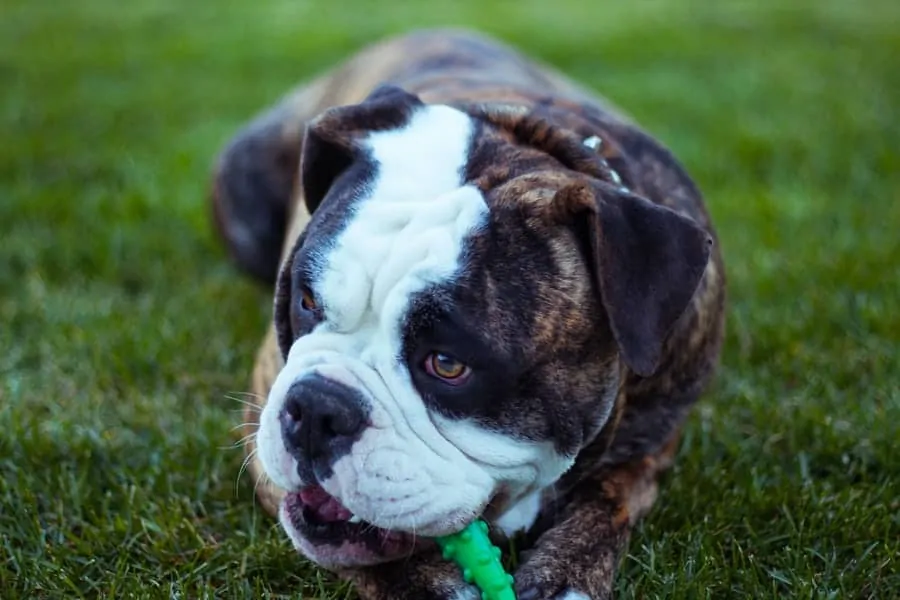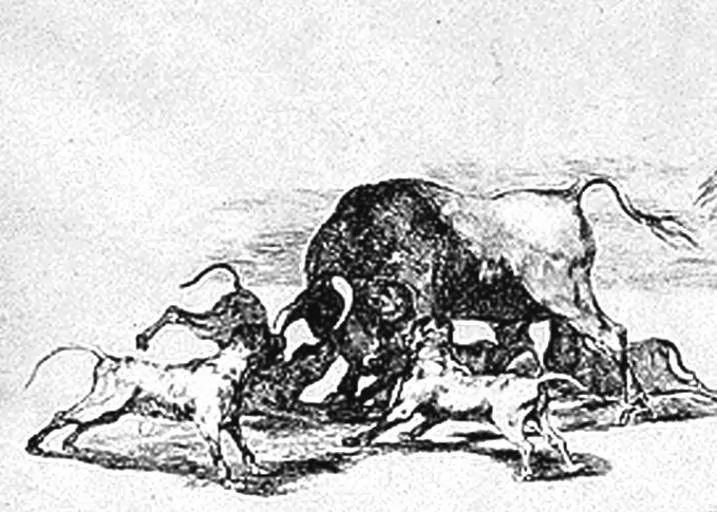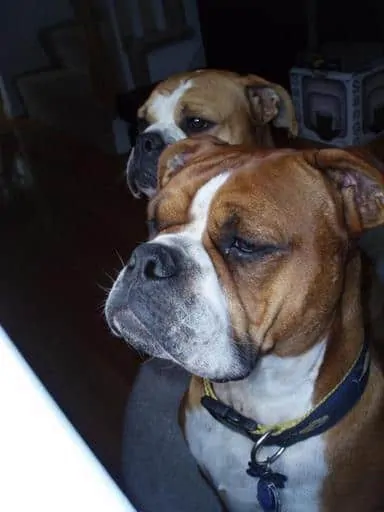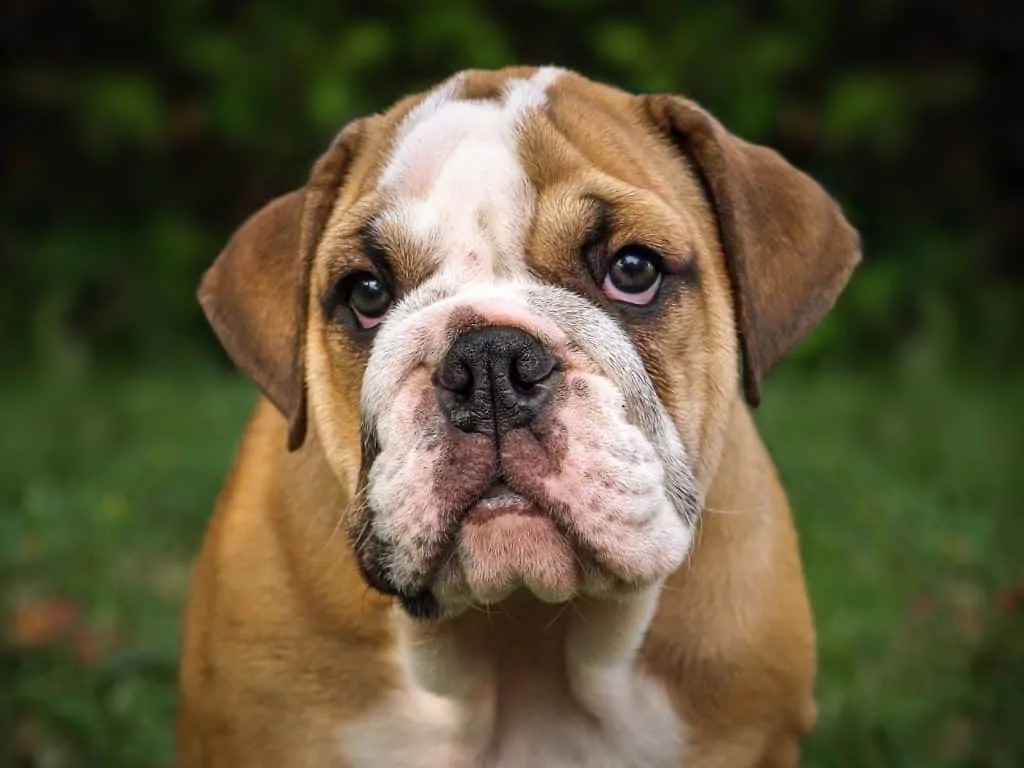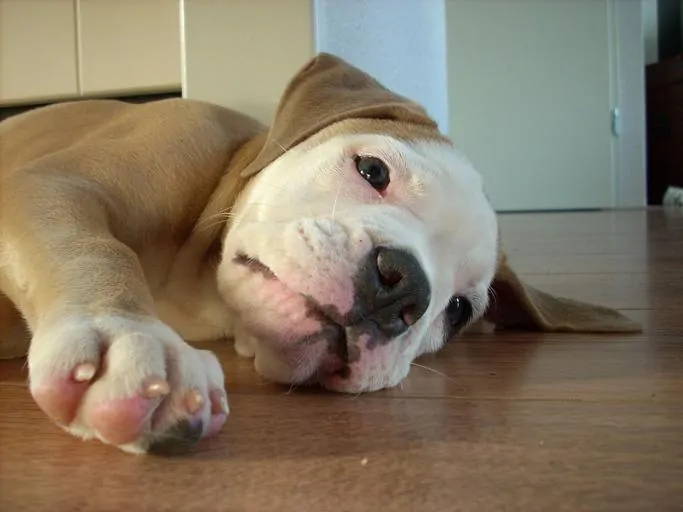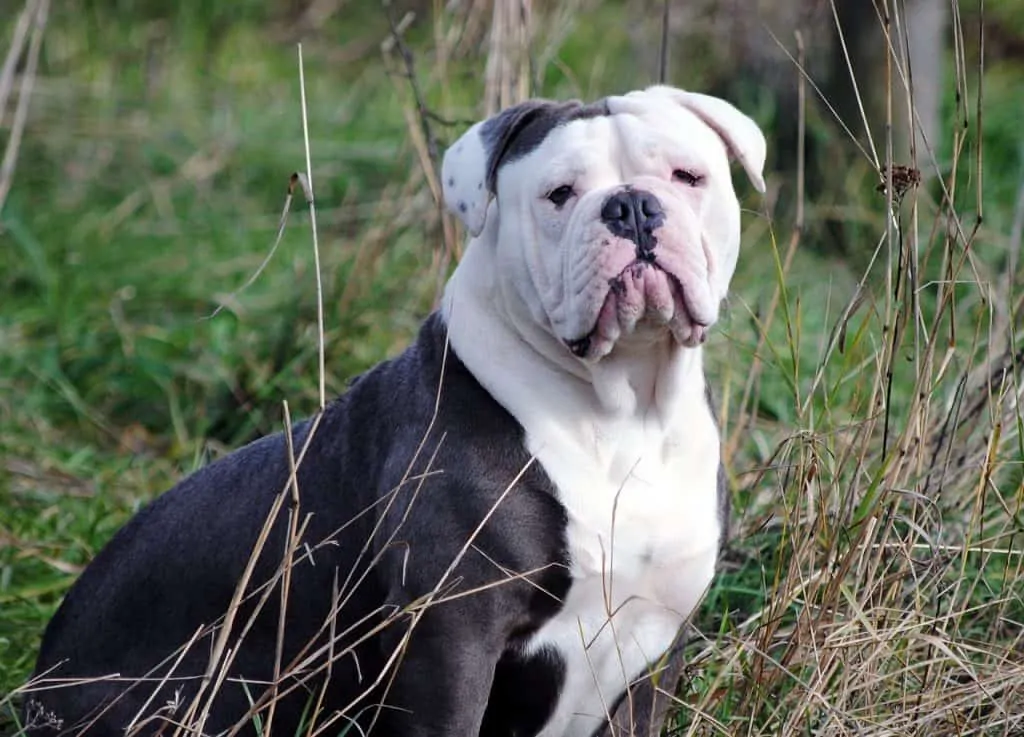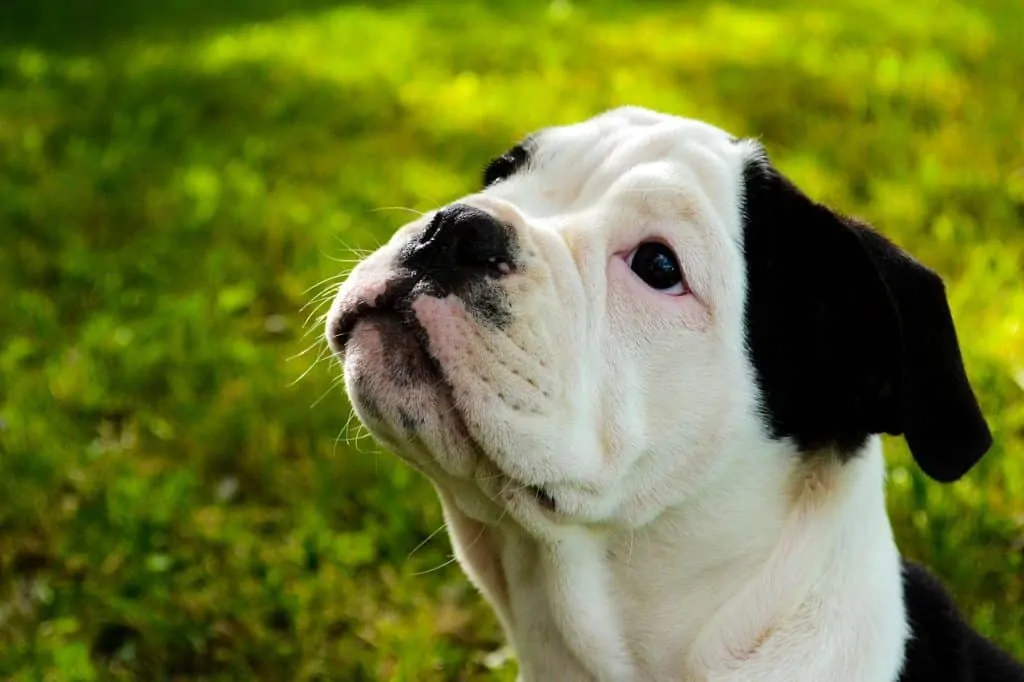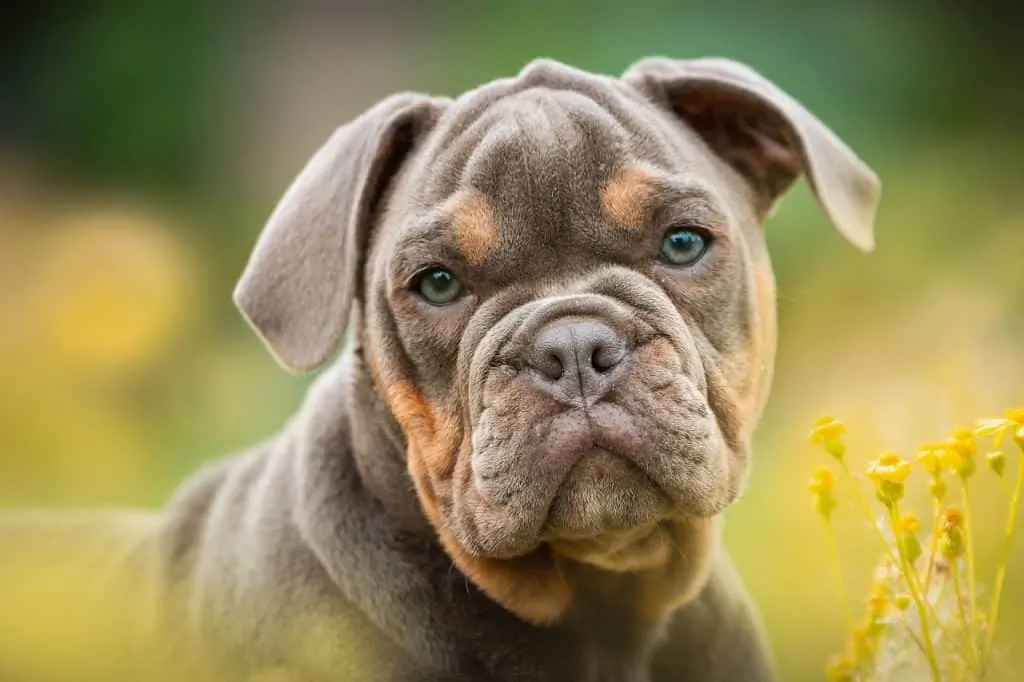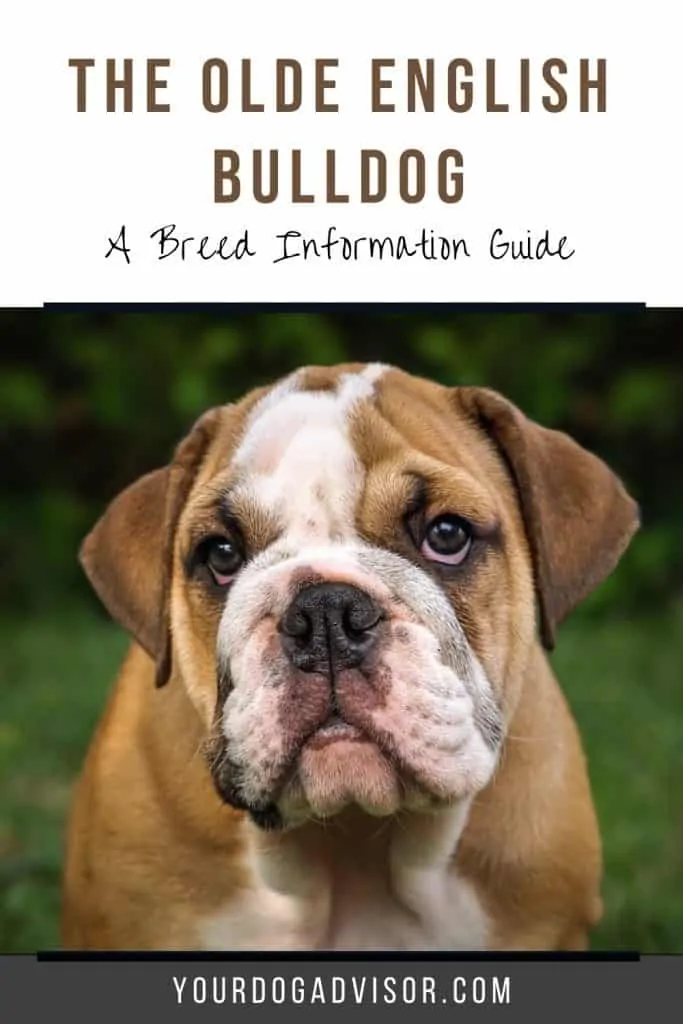Most of us know about the English Bulldog and other popular bully breeds, but the Olde English Bulldogge, or OEB as he is sometimes called, is a newer (and older) hybrid to the scene.
A recreation of a once extinct breed, the Olde English Bulldogge is steadily building a name and reputation for himself as a popular and loving companion. Built with vitality and temperament in mind, the OEB makes a loyal and loving companion for the right family.
Is the Olde English Bulldogge the right dog for you? Keep reading to find out.
Contents
What Is An Olde English Bulldogge?
The Olde English Bulldogge is an American hybrid dog.
Relatively new(ish) to the canine kingdom, the Olde English Bulldogge is an American-made hybrid designed to resemble the now extinct bulldog breed from the early bull baiting days of the 18th century.
The modern day Olde English Bulldogge is not like the traditional English Bulldog. Instead, he is a mix between several purebred dogs including:
This is a dog who still has yet to be recognized by the American Kennel Club and was only just recognized by the United Kingdom Club on January 1st, 2014. This means he is not eligible to participate in AKC Dog shows, but can possibly participate elsewhere in different clubs.
But why create a new bulldog breed to resemble an old, extinct one? Modern day bulldogs are popular for sure, but they are also riddled with health issues including breathing difficulties, skin ailments, and food sensitivities. Bulldogs are also notorious for their short lifespans.
The Olde English Bulldogge was created in an effort to reduce these health issues and bring back what once was a standard, healthy and long-lived bulldog breed. After decades of perfecting, the Olde English Bulldogge is finally ready to make his mark.
He is beloved for his sweet temperament, loyal demeanour, and intelligent thinking. In fact, many Olde English Bulldogge breeds are steadily finding their niche as service dogs and support animals, as they are considered sincerely emotionally intelligent breeds who bond closely with their family members.
Large, athletic, and coming from a versatile background, the Olde English Bulldogge is beloved by many enthusiasts. That said, he does have a unique history that, like many bully breeds, has led to a bad reputation over the years.
Take a look.
Where Does The Olde English Bulldogge Come From?
The Olde English Bulldogge is a hybrid dog designed to recreate a now extinct Bulldog from the 18th Century.
To be new and old at the same time is certainly a feat, but it’s nothing for the Olde English Bulldogge. This is a breed who is a modern-day recreation of the original and now extinct 18rh century Bulldog, who was a popular bull baiting canine from around 1100 up until 1835.
The original bulldogs were bred with large heads and jaws, stocky, athletic bodies, and a tenacity and courage that compelled them to do their masters bidding, even if it was to their own detriment.
In 1835, when animal rights activists banned the sport of bull baiting, bulldogs began to lose their value. In an effort to breed out aggression and other undesirable traits in the bulldog, they were selectively refined and produced with flatter faces and other physical traits that led to an abundance of health issues.
Subsequently, the original Bulldog was lost, making way for new bulldog breeds with undeniably sweet temperaments but also a number of severe health problems.
However, in 1971, bully enthusiasts decided to recreate the once vibrant and healthy bulldog, and opted to bring the breed back using a line breeding practice created by Dr. Fechimer. This practice was designed to quickly and effectively create new purebred dogs – a process that generally takes generations to perfect.
As a result, the Olde English Bulldogge was born. And though he still has yet to make himself a purebred staple on the American Kennel Club’s list of purebred dogs, he is already recognized under many other purebred categories throughout the world.
These clubs include the American Canine Association INc, the Backwoods Bulldog Club, the American Pet Registry, the Dog Registry of America, the Continental Kennel Club, the United Kingdom Kennel Club, and more.
What Are The Olde English Bulldogge Temperament And Personality Traits Like?
This is an adaptable breed who can do well with people and other dogs so well as he is properly trained and socialized.
While the Olde English Bulldogge was modeled after a breed designed for dog fighting sports, the modern day Olde English Bulldogge is actually quite even-tempered, gentle and calm. He makes for a great family dog and gets on well with children, exhibiting patience and love.
He is fiercely protective of his family, however, and can be wary of strangers if not properly socialized. Obedience training and socialization are key for any large breed, especially breeds who may be prone to guarding tendencies.
Otherwise, the Olde English Bulldogge makes a good dog for novice and experienced dog owners alike. He is trainable, easy going, and relatively low maintenance.
They are eager to please dogs who enjoy learning and will do best with positive reinforcement training techniques, which we will discuss further down.
That said, it has been reported that some Olde English Bulldogge breeds have difficulty with other dogs, especially those of the same sex. The Olde English Bulldogge may also have a tendency to be “bull-headed” (pun intended) during training if the sessions become boring or if negative reinforcement methods like punishment and scolding are used too harshly.
We should also note that the Olde English Bulldogge is very affectionate and becomes very closely bonded with his family members. This means he could exhibit some separation anxiety if left on his own for too long, which could lead to undesirable and destructive behaviors like chewing or potty accidents.
It’s important not to punish a dog for anxiety-related misbehaviors, as punishment could exacerbate the issue and lead to further problems. Instead, try and monitor your dog and learn what his behavior is stemming from, then work with a trusted trainer or professional to help mediate these behaviors.
What Does The Olde English Bulldogge Look Like?
Olde English Bulldogges are larger than the traditional English Bulldog, with a longer muzzle.
Larger than the bulldogs most of us are used to, and with a more pronounced muzzle, the Olde English Bulldogge was designed to more closely resemble his now extinct 18th century bulldog counterparts.
These physical characteristics are not by chance and in fact were carefully reconstructed by breeders who were devoted to ensuring the breed’s health and quality of life.
Olde English Bulldogge Height: 15 to 19 Inches
Olde English Bulldogge Weight: 50 to 80 Lbs
Olde English Bulldogge Coat Color: Black, brindle and white, fawn brindle, grey, black brindle, and red brindle
Coat Type: Short to medium in length, smooth, shedding
Hypoallergenic Coat: No
In general, the Olde English Bulldogge is a well-built, athletic dog. He has a wide chest, stocky body, and longer muzzle, though he still maintains that signature bulldog look. He also has wide eyes, a long tail, and short, floppy ears.
How Do You Groom an Olde English Bulldogge?
OEB’s are known to be droolers and will need to be wiped down quite frequently.
Grooming requirements are moderate when it comes to the Olde English Bulldogge. This is a dog who is only a mild shedder and who will do well with weekly brushing to collect and remove loose hair and debris from his coat. The breed may need twice weekly brushing during shedding season in spring and fall, when he will shed a bit more.
Along with moderate brushing using a slicker brush or deshedding tool, the Olde English Bulldogge will also need his nails trimmed or ground down regularly. This is a dog who is athletic and active and could be prone to splitting or cracking his nails if they are not properly filed.
His ears should be checked and cleaned routinely to ensure they are free of buildup and debris, and his teeth should be brushed at least once a day using a quality dog toothbrush and doggy shampoo.
Bathing is minimal unless he gets very dirty, with most Olde English Bulldogge breeds only needing a bath once every three months or so. In between bathing, you can use specified grooming wipes made with gentle ingredients to give his coat a once over and reduce doggy odor. Rubbing a small amount of coconut oil over your Olde English Bulldogge’s fur can also help reduce doggy odor and increase coat and skin health.
Like many bully breeds, the Olde English Bulldogge does have larger jowls and can be prone to more extensive drooling and slobbering, which is especially prevalent after eating, drinking, playing or exercising. Many owners keep a towel on hand to wipe their Olde English Bulldogge’s muzzle down to keep all this excess slobber under control.
What Is the Average Lifespan Of A Olde English Bulldogge And Does He Have Any Serious Health Issues?
Like all dogs, the OEB can suffer from some serious health issues.
One of the great things about the Olde English Bulldogge is that he was bred with health in mind. This means he is one of the most long-lived in the Bulldog family, with a lifespan of around 9 to 14 years.
Best of all, his life will be full and happy, as his list of health issues is much shorter than some of his other bully counterparts. That said, like all dogs, the Olde English Bulldogge still can be prone to some genetic health concerns, and these concerns can be exasperated if you do not get your Olde English Bulldogge puppy or rescue from a responsible source.
Some of the most common health concerns in the Olde English Bulldogge include Canine Hip Dysplasia and Gastric Dilation Volvulus, AKA Bloat.
Canine Hip Dysplasia
Canine Hip Dysplasia commonly occurs in large, muscular dogs like the Olde English Bulldogge, and is a skeletal issue that focuses on the hip joints. Essentially, the hip sockets in dogs with hip dysplasia have not developed properly and are grinding on one another, causing a variety of symptoms including pain, limping, decreased activity, reluctance playing, difficulty climbing stairs, getting to and from the bed or couch, and so on.
There is no cure for Canine Hip Dysplasia, but there are ways to help ease it. Ensuring your dog is on a balanced diet that contributes to a healthy weight is imperative, as is making sure your Olde English Bulldogge is monitored during exercise, maintains routine vet visits, takes joint fluid modifiers and supplements, and undergoes physical therapy.
Bloat
Also known as gastric torsion, gastric dilation volvulus, or GVD, Bloat is a serious and often fatal condition in dogs that occurs suddenly when gas, fluid or air builds up in the stomach and causes the organ to flip.
Symptoms of bloat include a distended stomach, unproductive vomiting, panting, obvious pain, restlessness, and eventual collapse.
There are a few common causes of Bloat, and some breeds are more susceptible than others. Dogs with deep, large chests like the Olde English Bulldogge are some of the most prone to this disorder, and it can be triggered by eating too quickly, eating too much, overexercising, overexcitement, or eating a meal directly after a hearty play or exercise routine.
If you notice any symptoms of Bloat in your Olde English Bulldogge, it is vital you get him to the nearest emergency vet as soon as possible.
While there are times Bloat can be unpredictable, there are things you can do to help reduce your dog’s chances of suffering from this devastating condition.
Investing in a slow feeder can help slow your dog down during mealtime and ensure he eats at a safe pace. You should also make sure to monitor your Olde English Bulldogge during exercise and ensure he settles down for a good half hour to 45 minutes before meals.
What Are The Exercise and Training Requirements For A Olde English Bulldogge?
Olde English Bulldogges are naturally more athletic than some other bully breeds and will need routine exercise.
On the subject of exercise, the Olde English Bulldogge is designed to be more active than his other bulldog counterparts. He is an athletic dog breed who needs consistent exercise each and every day to stay happy and healthy.
A good 45 minute to an hour walk each day should suffice, or some playtime in a yard that involve games like fetch or tug of war.
That said, the Olde English Bulldogge is also an adaptable dog. He does not necessarily need a lot of space in homes to be happy and have all of his needs met. Obedient and mild-mannered, the Olde English Bulldogge makes an excellent apartment dog so long as he is able to get out and walk each day. He also does well as a travel companion on road trips.
As far as training goes, the Olde English Bulldogge is an intelligent and eager to please breed who will enjoy learning new tricks and ques. However, he can be stubborn, especially if training becomes monotonous or if punishment or scolding is used.
To keep your Olde English Bulldogge’s attention during training, try to keep the sessions short, game-like and fun, and use food motivation like treats.
Because the Olde English Bulldogge could have a tendency to suffer from separation anxiety, he would be a good candidate for crate training. When done properly, crate training is highly beneficial and can help alleviate anxiety and stress, as well as offer your dog a space of his own where he can go to have breaks or rest away from the family.
Along with making sure you properly train your Olde English Bulldogge, it’s imperative that this dog is also properly socialized. Socializing your dog from an early age can help ensure he grows up happy, healthy and well rounded.
To properly socialize your Olde English Bulldogge, try and introduce him to as many new experiences, people, places, sounds and sights as possible. Make sure these experiences are positive for him to better help him build trust and confidence.
The Olde English Bulldogge may also benefit from obedience training, and should be exposed to children and other pets early on. Make sure any children in the home are also taught how to safely and respectfully interact with their dog, and supervise young children around the Olde English Bulldogge to ensure everyone is getting along swimmingly.
What Are Some Pros And Cons Of Owning A Olde English Bulldogge?
OEB’s are great dogs, but they are not the right dogs for everyone.
The Olde English Bulldogge certainly has some winning qualities, but that doesn’t mean he’s the right dog for everyone. Are you wondering if this hybrid is the right dog for you and your family?
Let’s take a look at some of the pros and cons of owning an Olde English Bulldogge.
Pros To Owning A Olde English Bulldogge:
- Olde English Bulldogges are eager to please and easy to train
- They make good family dogs and are patient with children
- Olde English Bulldogges are calm, making great apartment dogs
- The Olde English Bulldogge is healthier than many other bulldog breeds
Cons To Owning A Olde English Bulldogge:
- Olde English Bulldogges could have guarding instinct if not properly socialized
- They need extensive training to ensure they grow up well mannered
- The Olde English Bulldogge is prone to some serious health concerns like Bloat
- The Olde English Bulldogge is currently not considered a purebred in the US
- The Olde English Bulldogge does have the potential to be aggressive against other dogs of the same sex
What Is The Ideal Home Type For A Olde English Bulldogge?
The Olde English Bulldogge is versatile dog who does well in both apartments and larger homes.
Because of his versatile and adaptable nature, the Olde English Bulldogge actually makes a wonderful pet for both suburban and city life. He can do well in larger homes with lots of land but may also thrive in apartments, so long as his daily exercise needs are met.
He will do best in families who have flexible schedules and time to train and socialize their dog from an early age. That said, the Olde English Bulldogge has the potential to make a fine companion for seniors, families, singles, and those with children and other pets.
Choosing A Olde English Bulldogge Puppy Or Rescue – Tips On Finding The Healthiest Olde English Bulldogge Possible.
Make sure you go through reputable sources when looking for an OEB puppy or rescue.
The Olde English Bulldogge was bred for health and vitality, but that doesn’t mean every Olde English Bulldogge you come across is going to have good stock. Responsible breeding practices are key to getting a healthy Olde English Bulldogge, and it’s important to go through reputable sources when looking for an Olde English Bulldogge puppy or rescue.
If you plan on going through a breeder to get an Olde English Bulldogge puppy, make sure you do plenty of research and don’t be afraid to ask questions. Responsible breeders will have had their puppies health screened and will be able to provide you with certificates proving they have been cleared of any serious health issues.
You may also be able to take a look at the puppy’s mother dog to get a better idea of what your Olde English Bulldogge will grow up to look like and even behave like.
On average, buying an Olde English Bulldogge from a breeder costs around $2,000 to $3,000. While this is a hefty price, it’s important not to try and cut corners by going through backyard breeders or online sellers in search of a puppy at a discounted rate.
This is how many people wind up accidentally supporting puppy mills or even ending up with a very sick puppy.
You also have the option of going through a rescue or shelter to adopt an Olde English Bulldogge. Rescuing a dog is often a fraction of the price of going through a breeder and comes with its own list of benefits.
Many shelters offer free initial vet exams and will have even given the dogs in their care a behavioral screening to ensure they get adopted out to the right families. It’s a win-win for everyone!
The Top 5 Products Every Olde English Bulldogge Owner Needs
Make sure you have the proper gear to get your OEB started off right!
Whether you’ve decided to adopt a rescued Olde English Bulldogge or you’re planning on bringing home a puppy, preparation is key to ensuring you and your dog start off on the right foot.
The Olde English Bulldogge is quite the mix, adding a splash of intelligence, vitality, and an athletic personality to the Bulldog family. As such, he has a few unique needs, but luckily there are some products that can help any potential Olde English Bulldogge mom or dad get a running start.
Let’s take a look at the top five products every Olde English Bulldogge owner needs to help their dog thrive.
PetFusion Ultimate Orthopedic Dog Bed
[amazon box=”B00TQ47CPW” style=”light” title=”Orthopedic Dog Bed” template=”widget” ]
Your Olde English Bulldogge could be prone to joint issues like hip dysplasia, which can lead to a further list of problems for your pooch down the road. To help combat symptoms of joint pain in your dog, we recommend investing early in an orthopedic dog bed like the memory foam bed by PetFusion listed above.
This bed is designed specifically for dogs with joint issues and can help prevent them as well as help soothe any that are already ongoing.
The bed can be ordered in different sizes and colors depending on your needs and decorating style, and includes a machine washable cover for easy upkeep.
Doggie Dailies Glucosamine For Dogs
[amazon box=”B07Y5HDHMM” style=”light” title=”Doggie Dailies Glucosamine” template=”widget” ]
Supplements are a healthy and safe way to keep your Olde English Bulldogge’s hips and joints healthy. The order above includes 225 chews that taste like yummy treats to your dog. They are made with quality ingredients including essential enzymes, vitamines, minerals, and more to help improve joint health, mobility, and overall comfort.
The supplements are also made with salmon oil and cod liver oil, meaning they are rich in healthy fatty acids that can aid in overall skin and coat health.
Outward Hound Slow Feeder Dog Bowl
[amazon box=”B00FPKNRG4″ style=”light” title=”Outward Hound Slow Feeder” template=”widget” ]
A slow feeder is a must-have for any dog who has the potential of suffering from Bloat. The above slow feeder dog bowl by Outward Hound is designed to make eating a fun game for dogs while also ensuring they eat slowly, reducing the amount of air being swallowed.
The feeder can be ordered in different sizes, but we recommend the regular or large size for your Olde English Bulldogge. You can also order it in different colors.
Pogi’s Hypoallergenic Grooming Wipes
[amazon box=”B010MVG6ZY” style=”light” title=”Grooming Wipes” template=”widget” ]
The Olde English Bulldogge only needs bathing once every few months unless he gets especially dirty. Between routine bathing, you can give your Olde English Bulldogge a good wipe down with some quality grooming wipes.
The above grooming wipes by Pogi’s Pet Supplies are hypoallergenic, natural, and environmentally friendly. They are made with soothing, plant-based ingredients that are good for your dog. These wipes will help reduce dandar buildup, loose hair, and of course that stinky dog smell.
The PetSafe Easy Walk Dog Harness
[amazon box=”B0009ZBKG4″ style=”light” title=”PetSafe Easy Walk Dog Harness” template=”widget” ]
The Olde English Bulldogge is especially strong and athletic, and while he is normally a docile dog, he can have a tendency to pull on leash if he gets too excited.
Easy Walk harnesses that clip in front like the harness listed above can help reduce your dog’s natural urge to pull while also safely redirecting him back to your side without putting pressure on his trachea.
And that’s about it! So, what do you think about the interesting and new (but old) Olde English Bulldogge hybrid? Tell us if this is the dog of your dreams in the comment section below.

Jen Jones is a professional dog trainer and behavior specialist with more than 25 years of experience. As the founder of ‘Your Dog Advisor’ and the ‘Canine Connection’ rehabilitation center, she applies a holistic, empathetic approach, aiming to address root causes rather than merely treating symptoms.
Well known for her intuitive and compassionate approach, Jen adopts scientifically-proven, reward-based methods, encouraging positive reinforcement over punishment. Jen specializes in obedience training, behavior modification, and puppy socialization. Her innovative methods, particularly in addressing anxiety and aggression issues, have been widely recognized. Jen has worked with many of the world’s leading dog behaviorists and in her free time volunteers with local animal shelters and rescue groups.
